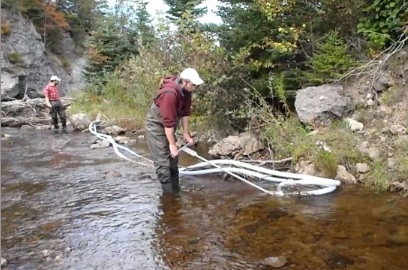 Stream bank erosion and poor land use practices are both major sources of sand and silt in streams. Sand and silt buildup affects streams by infilling the interstitial spaces. When the interstitial spaces are infilled watercourses over widen and there is little or no flow through the streambed and through fish spawning beds. When gravel and cobble are buried in sand and silt organic material from the riparian areas to support the food web is lost and there is limited habitat available for aquatic insects. A major affect of the infilling of interstitial spaces in streams is that instream cover and fish over wintering habitat is lost.
Stream bank erosion and poor land use practices are both major sources of sand and silt in streams. Sand and silt buildup affects streams by infilling the interstitial spaces. When the interstitial spaces are infilled watercourses over widen and there is little or no flow through the streambed and through fish spawning beds. When gravel and cobble are buried in sand and silt organic material from the riparian areas to support the food web is lost and there is limited habitat available for aquatic insects. A major affect of the infilling of interstitial spaces in streams is that instream cover and fish over wintering habitat is lost.
There are many techniques to reduce the amount of sand and silt in streams such as instream structures that sort gravels such as digger logs, deflectors and rocksills. Fire hoses are used to wash gravel spawning beds and vacuum trucks are used to remove sediment blockages. But none of these techniques actually remove the sand from the gravel and cobble substrate and remove it from the stream.
The SandWand technique removes sand and silt from streams while leaving gravel and larger rocks behind without having any long-term effects on stream habitat. The SandWand system includes two 2-inch trash pumps connected to a stainless steel wand that is worked by one operator. The operator simply rocks the SandWand back and forth on the surface. One pump injects water through a 1.5 inch hose to a nozzle in the wand directed to the bottom of the stream and the other pump draws off the water, sand and silt slurry leaving gravel that is 1/8 inch and larger in the stream. A net flow into the wand prevents turbidity in the stream. The low turbidity water, sand and silt is discharged into the riparian area or into a sand collector. The clean water flows back into the stream upstream of the worksite. The SandWand is used for both deep cleaning in pools and light cleaning in riffles. It is not used on riffle crests to prevent low flows from seeping through drying up the stream.
The SandWand technique is very effective. It removes sand and silt down to 40 cm with only short-term impacts on insect populations. The insects appear to fully recover within 10 days via drift. There are no effects on fish populations after 24 hours. There are indications that water temperatures are lowered and daily fluctuations in temperature are stabilized.
